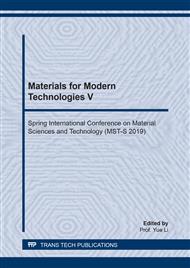[1]
G. Kulesza, P. Panek, P. Zieba, Time efficient texturization of multicrystalline silicon in the HF/HNO3 solutions and its effect on optoelectronic parameters of solar cells, Arch Civ Mech Eng, 14 (2014) 595-601.
DOI: 10.1016/j.acme.2014.02.007
Google Scholar
[2]
J. Jin, H. Shen, P. Zheng, K.S. Chan, X. Zhang, H. Jin, >20.5% Diamond Wire Sawn Multicrystalline Silicon Solar Cells With Maskless Inverted Pyramid Like Texturing, IEEE Journal of Photovoltaics, 7 (2017) 1264-1269.
DOI: 10.1109/jphotov.2017.2717820
Google Scholar
[3]
H. Jansen, M.D. Boer, J. Burger, R. Legtenberg, M. Elwenspoek, The black silicon method II:The effect of mask material and loading on the reactive ion etching of deep silicon trenches, in: International Conference on Micro-& Nano-engineering, (1994).
DOI: 10.1016/0167-9317(94)00149-o
Google Scholar
[4]
G.N. Huang Z, Werner Metal-Assisted Chemical Etching of Silicon_ A Review, Adv. Mater., 23 (2011) 285-308.
Google Scholar
[5]
H. Li, Fabrication of ultra-high aspect ratio (>160:1) silicon nanostructures by using Au metal assisted chemical etching, Journal of Micromechanics and Microengineering, (2017).
DOI: 10.1088/1361-6439/aa96c4
Google Scholar
[6]
X. Ye, S. Zou, K. Chen, J. Li, J. Huang, F. Cao, X. Wang, L. Zhang, X.-F. Wang, M. Shen, X. Su, 18.45%-Efficient Multi-Crystalline Silicon Solar Cells with Novel Nanoscale Pseudo-Pyramid Texture, Adv. Funct. Mater., 24 (2014) 6708-6716.
DOI: 10.1002/adfm.201401589
Google Scholar
[7]
S.K. Srivastava, P. Singh, M. Yameen, P. Prathap, C.M.S. Rauthan, Vandana, P.K. Singh, Antireflective ultra-fast nano scale texturing for efficient multi-crystalline silicon solar cells, Solar Energy, 115 (2015) 656-666.
DOI: 10.1016/j.solener.2015.03.010
Google Scholar
[8]
J. Yoo, G. Yu, J. Yi, Large-area multicrystalline silicon solar cell fabrication using reactive ion etching (RIE), Sol. Energy Mater. Sol. Cells, 95 (2011) 2-6.
DOI: 10.1016/j.solmat.2010.03.029
Google Scholar
[9]
G. Du, L. Zhou, P. Rossetto, Y. Wan, Hard inclusions and their detrimental effects on the wire sawing process of multicrystalline silicon, Solar Energy Materials & Solar Cells, 91 (2007) 1743-1748.
DOI: 10.1016/j.solmat.2007.06.001
Google Scholar
[10]
B. Meinel, T. Koschwitz, C. Blocks, J. Acker, Comparison of diamond wire cut and silicon carbide slurry processed silicon wafer surfaces after acidic texturisation, Mater. Sci. Semicond. Process., 26 (2014) 93-100.
DOI: 10.1016/j.mssp.2014.03.046
Google Scholar


